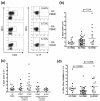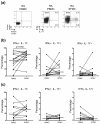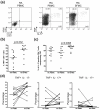Rheumatoid synovial fluid interleukin-17-producing CD4 T cells have abundant tumor necrosis factor-alpha co-expression, but little interleukin-22 and interleukin-23R expression
- PMID: 20929536
- PMCID: PMC2991017
- DOI: 10.1186/ar3152
Rheumatoid synovial fluid interleukin-17-producing CD4 T cells have abundant tumor necrosis factor-alpha co-expression, but little interleukin-22 and interleukin-23R expression
Abstract
Introduction: Th17 cells have been implicated in the pathogenesis of rheumatoid arthritis (RA). The aim of this study was to systematically analyse the phenotype, cytokine profile and frequency of interleukin-17 (IL-17) producing CD4-positive T cells in mononuclear cells isolated from peripheral blood, synovial fluid and synovial tissue of RA patients with established disease, and to correlate cell frequencies with disease activity.
Methods: Flow cytometry was used to analyse the phenotype and cytokine production of mononuclear cells isolated from peripheral blood (PBMC) (n = 44), synovial fluid (SFMC) (n = 14) and synovium (SVMC) (n = 10) of RA patients and PBMC of healthy controls (n = 13).
Results: The frequency of IL-17-producing CD4 T cells was elevated in RA SFMC compared with RA PBMC (P = 0.04). However, the frequency of this population in RA SVMC was comparable to that in paired RA PBMC. The percentage of IL-17-producing CD4 T cells coexpressing tumor necrosis factor alpha (TNFα) was significantly increased in SFMC (P = 0.0068). The frequency of IFNγ-producing CD4 T cells was also significantly higher in SFMC than paired PBMC (P = 0.042). The majority of IL-17-producing CD4 T cells coexpressed IFNγ. IL-17-producing CD4 T cells in RA PBMC and SFMC exhibited very little IL-22 or IL-23R coexpression.
Conclusions: These findings demonstrate a modest enrichment of IL-17-producing CD4 T cells in RA SFMC compared to PBMC. Th17 cells in SFMC produce more TNFα than their PBMC counterparts, but are not a significant source of IL-22 and do not express IL-23R. However, the percentage of CD4 T cells which produce IL-17 in the rheumatoid joint is low, suggesting that other cells may be alternative sources of IL-17 within the joints of RA patients.
Figures




References
-
- Morita Y, Yamamura M, Kawashima M, Harada S, Tsuji K, Shibuya K, Maruyama K, Makino H. Flow cytometric single-cell analysis of cytokine production by CD4+ T cells in synovial tissue and peripheral blood from patients with rheumatoid arthritis. Arthritis Rheum. 1998;41:1669–1676. doi: 10.1002/1529-0131(199809)41:9<1669::AID-ART19>3.0.CO;2-G. - DOI - PubMed
Publication types
MeSH terms
Substances
Grants and funding
LinkOut - more resources
Full Text Sources
Other Literature Sources
Medical
Research Materials

